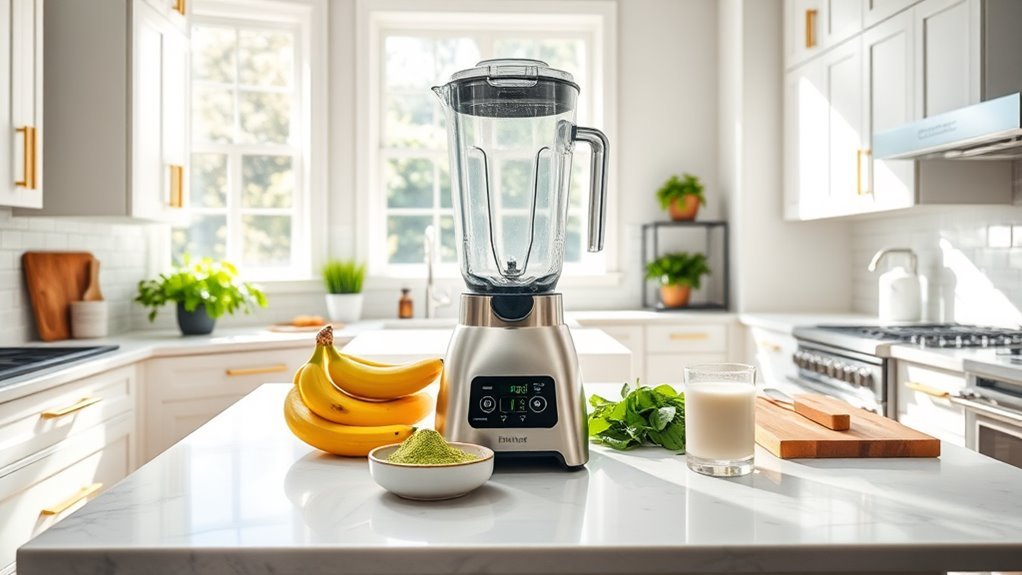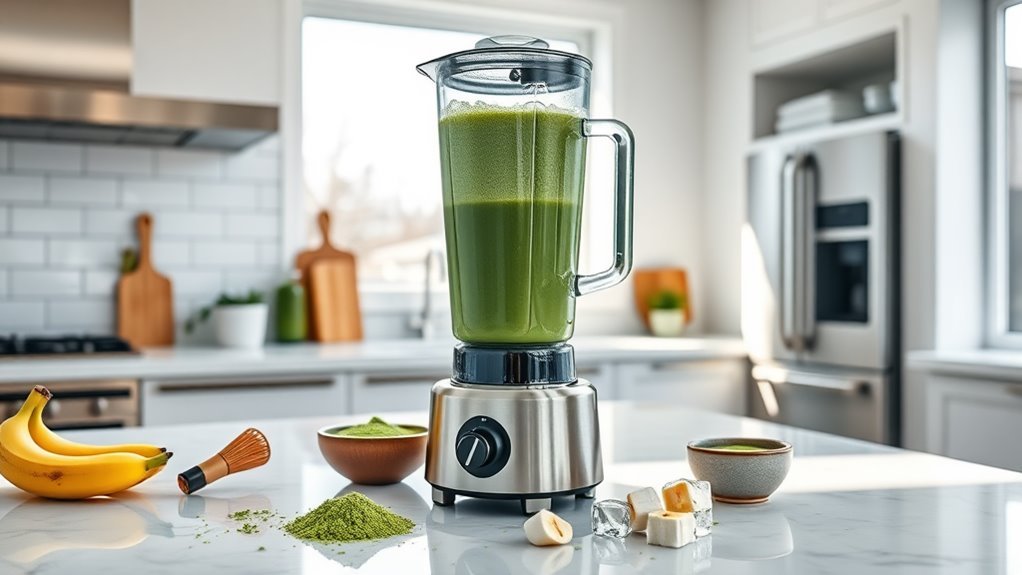Most people reach for coffee when energy levels dip, but perhaps there’s something to be said for matcha’s gentler approach. The green powder delivers caffeine without the familiar jitters—though admittedly, the taste takes some getting used to. What makes it particularly interesting for smoothies is how it transforms what could be just another breakfast drink into something that actually sustains energy for hours. The real question becomes whether convenience can match effectiveness.
Why Matcha Makes the Perfect Smoothie Base

Matcha’s earthy complexity transforms an ordinary smoothie into something that feels almost intentionally sophisticated, though perhaps that sounds a bit pretentious for what amounts to blended spinach and banana.
The powder dissolves completely, creating this vibrant green base that actually masks the vegetable taste better than you’d expect.
There’s something about matcha’s slight bitterness that balances sweetness without requiring extra sugars. It provides sustained energy too, unlike the quick spike from fruit-heavy smoothies.
The umami undertones work surprisingly well with creamy textures, making even the simplest four-ingredient blend feel substantial and satisfying rather than just another health drink. Additionally, using a high-performance blender helps achieve the smoothest texture, enhancing the overall experience of the matcha smoothie.
Simple 4-Ingredient Recipe for Busy Mornings
When mornings feel like a race against the clock, this four-ingredient smoothie becomes something of a lifesaver. The beauty lies in its simplicity—just matcha powder, baby spinach, almond milk, and half a frozen banana.
Four simple ingredients transform chaotic mornings into manageable moments—matcha, spinach, almond milk, and banana create an unexpectedly perfect lifesaver.
Perhaps the most appealing aspect is how quickly everything comes together. Toss ingredients into the blender, secure the lid, and blend on medium speed until the spinach breaks down completely. High-performance blenders can handle tough ingredients like nuts and frozen fruits, ensuring a smooth and consistent texture.
The whole process takes maybe five minutes, though some mornings it feels even faster.
The result is surprisingly smooth and energizing. It’s almost too easy, really—which makes it perfect for those particularly hectic days.
Step-by-Step Blending Instructions

Getting the blending technique right makes the difference between a smooth drink and one with fibrous bits floating around.
Start by adding the almond milk first—this helps the blender blades move more efficiently. Then add the frozen banana, followed by spinach and matcha powder.
Begin blending on medium speed rather than jumping straight to high. The spinach needs time to break down properly, and rushing this step often leaves you with stringy pieces.
Most blenders require about sixty seconds of steady blending, though older models might need longer. Perhaps check the consistency halfway through and adjust accordingly.
Health Benefits and Customization Tips
Beyond the vibrant green color that makes this smoothie so Instagram-worthy, the nutritional profile here is actually quite impressive.
Matcha delivers sustained energy without the jitters, while spinach sneaks in vitamins without affecting taste. Perhaps that’s what makes this combination so appealing.
Customization options are fairly straightforward:
- Sweetness adjustment – Add dates or maple syrup if the banana isn’t quite enough
- Protein boost – Throw in vanilla protein powder for post-workout recovery
- Texture variation – Use fresh banana for thinner consistency, frozen for thickness
- Intensity control – Start with less matcha if you’re sensitive to caffeine
The flexibility makes it adaptable to different preferences.
Frequently Asked Questions
Can I Make This Smoothie the Night Before and Store It?
Matcha smoothies can be prepared the night before and refrigerated, though separation may occur. One should shake or stir before consuming, as the texture and vibrant green color may slightly diminish overnight.
What’s the Shelf Life of Matcha Powder Once Opened?
Opened matcha powder maintains ideal quality for six to twelve months when stored in an airtight container away from light, heat, and moisture. Proper storage prevents oxidation and preserves the powder’s vibrant color and nutritional benefits.
Is Ceremonial Grade Matcha Necessary or Can I Use Culinary Grade?
Ironically, ceremonial grade matcha might be wasted in smoothies where its delicate flavor gets masked. Culinary grade matcha works perfectly fine for blended drinks, offering the same nutritional benefits at a more economical price point.
Can I Substitute Fresh Spinach if I Don’t Have Baby Spinach?
Fresh spinach can substitute baby spinach in the smoothie recipe. However, fresh spinach leaves are larger and may require longer blending time to break down completely and achieve the desired smooth consistency.
How Much Caffeine Does This Smoothie Contain Compared to Coffee?
Two teaspoons of matcha powder contain approximately 60-70 milligrams of caffeine, roughly half the amount found in an average cup of coffee, which typically contains 95-140 milligrams of caffeine per serving.
Conclusion
Perhaps the most compelling example comes from Sarah, a marketing executive who replaced her afternoon coffee with matcha smoothies last year. She noticed sustained energy levels without the usual 3 PM crash. While individual results vary, the combination of natural caffeine and L-theanine in matcha seems to offer something different than traditional energy drinks. This simple four-ingredient blend might just transform your daily routine—though admittedly, the green color takes getting used to.

